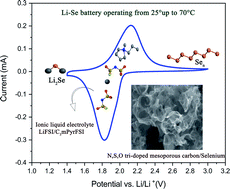A safe Li–Se battery in an ionic liquid-based electrolyte operating at 25–70 °C by using a N,S,O tri-doped mesoporous carbon host material†
Abstract
The selenium cathode for lithium–selenium batteries (Li–Se) has recently been recognized as an appealing high-energy alternative to sulfur due to its superior conductivity and chemical stability. These features open new possibilities such as alternative electrolytes that are known to be incompatible with a sulfur environment. In this work, we introduce a Li–Se battery comprising the non-flammable ionic liquid electrolyte (N-propyl-N-methyl pyrrolidinium bis(fluorosulfonylimide)) which allows the battery to operate stably from room temperature to up 70 °C. A N,S,O tri-doped mesoporous carbon is employed as a porous conductive network to host the selenium. At room temperature, the Li–Se battery shows capacity retention of 91% at 1C-rate after 100 cycles and can deliver a capacity up to 560 mA h g−1 at 0.2C. Due to the tailored electrolyte, the battery operates well at 70 °C, where capacity of 670 mA h g−1 is obtained at 0.25C and 94% capacity retention after 100 cycles at 0.5C-rate. Thus we demonstrate for the first time the compatibility of the ionic liquid electrolyte against selenium in a Li–Se battery for large scale energy storage applications.



 Please wait while we load your content...
Please wait while we load your content...